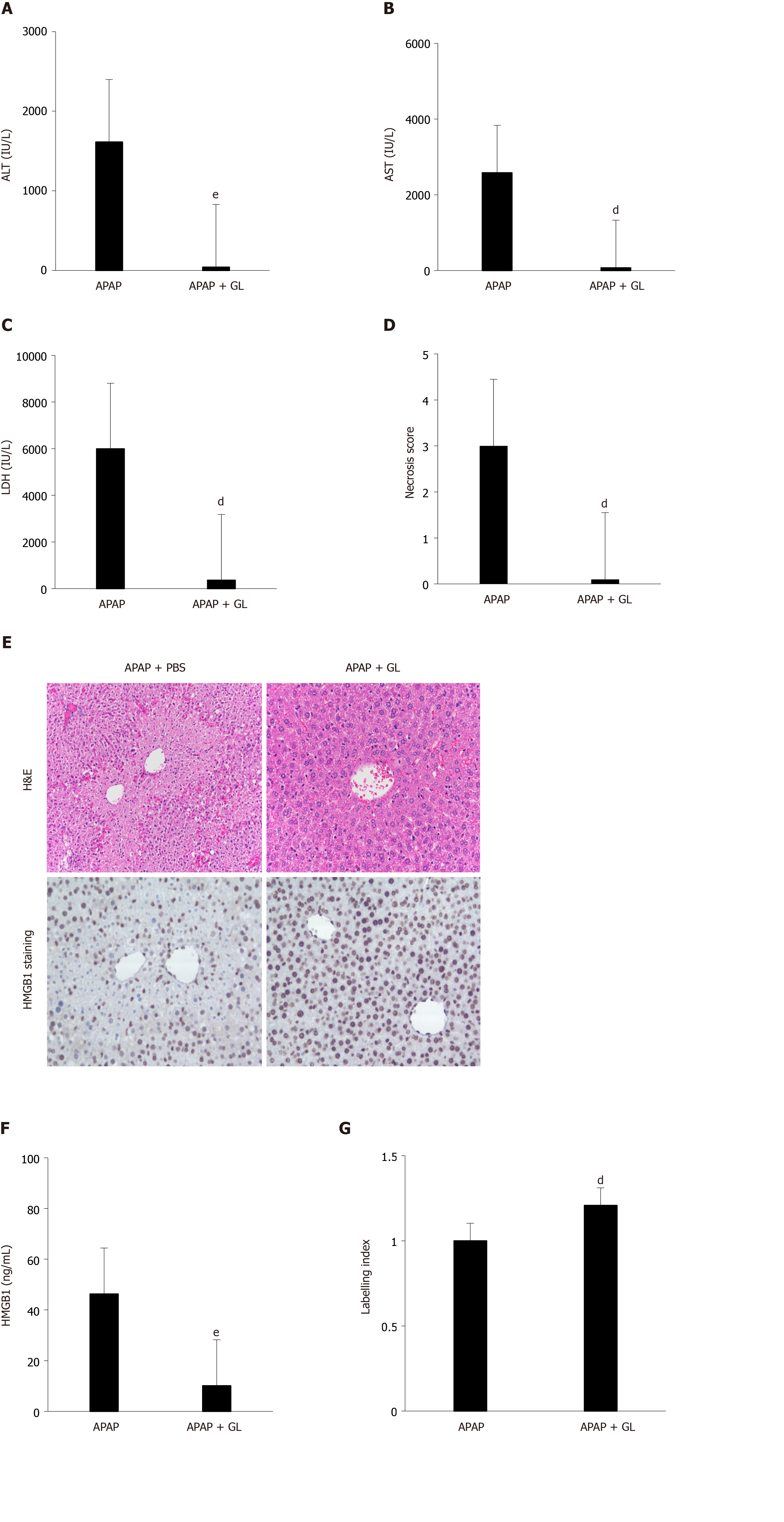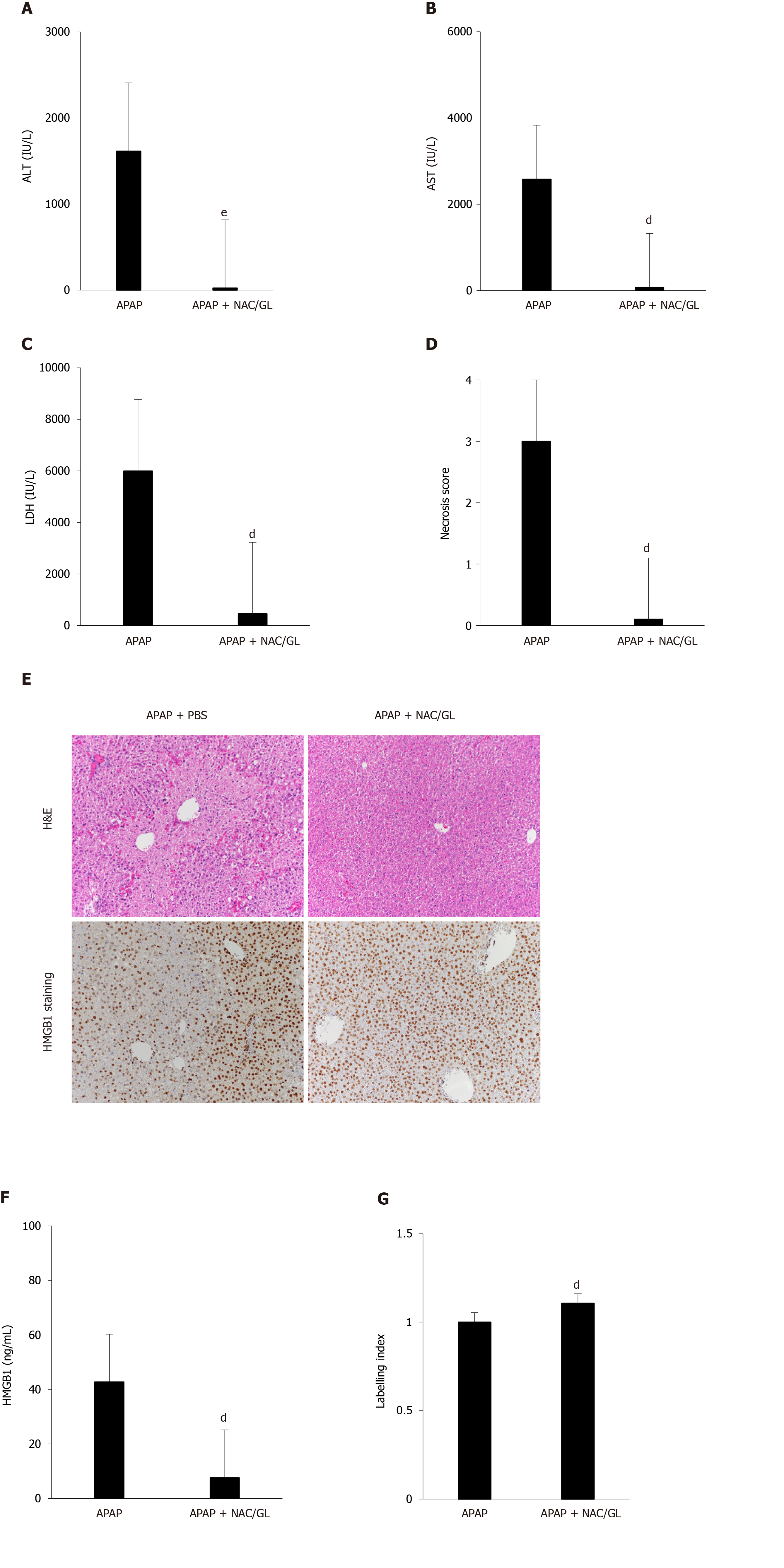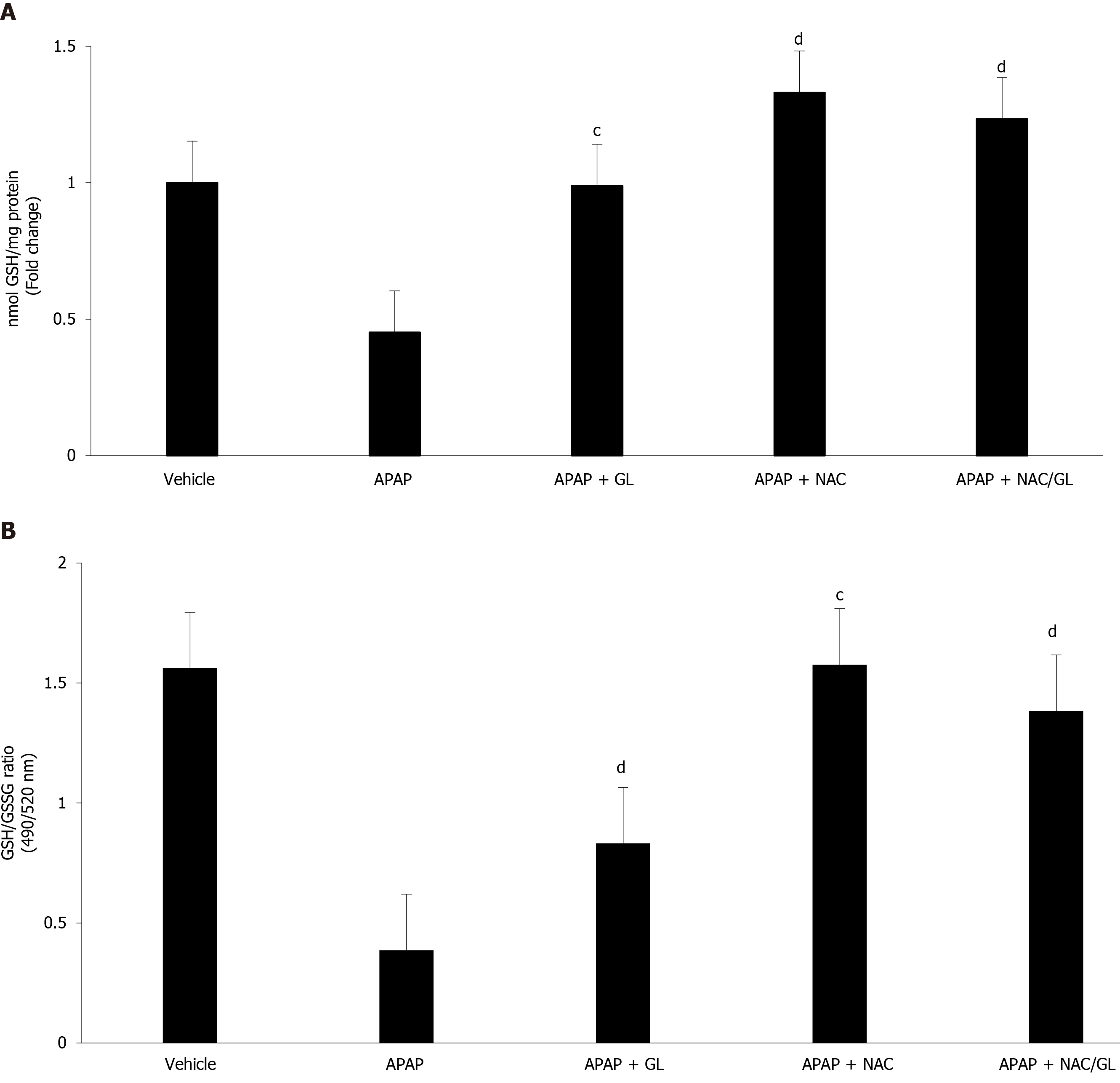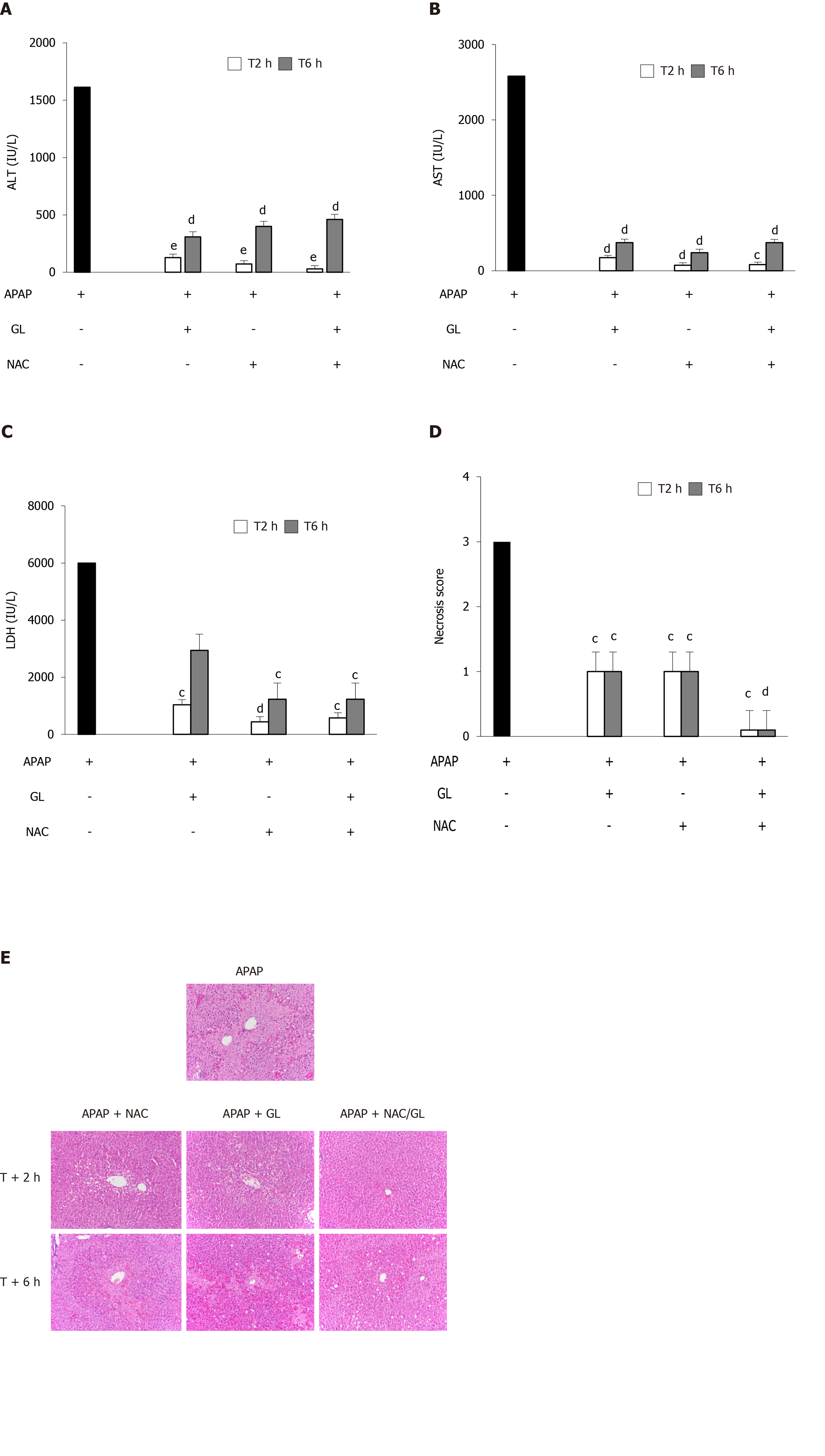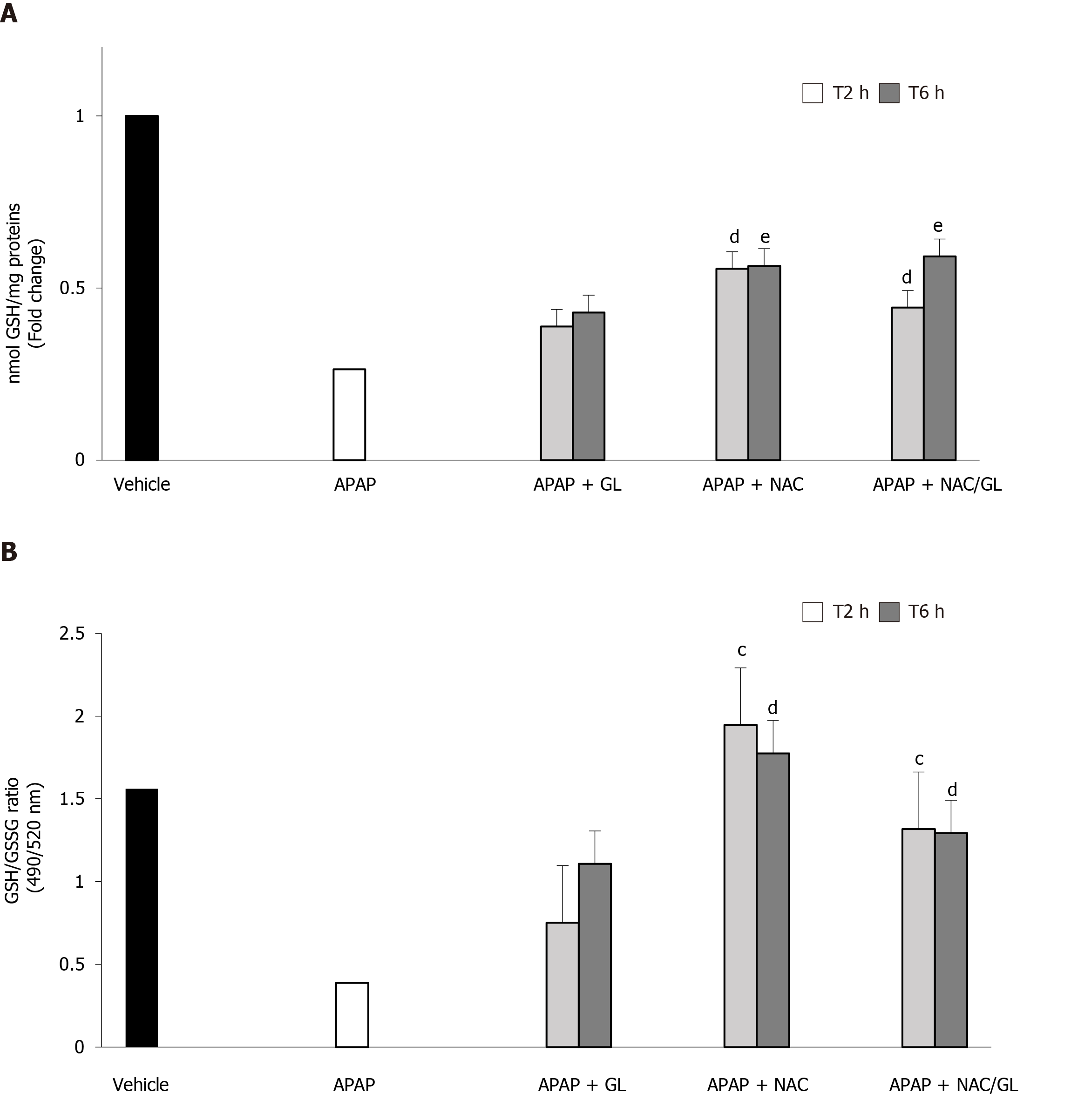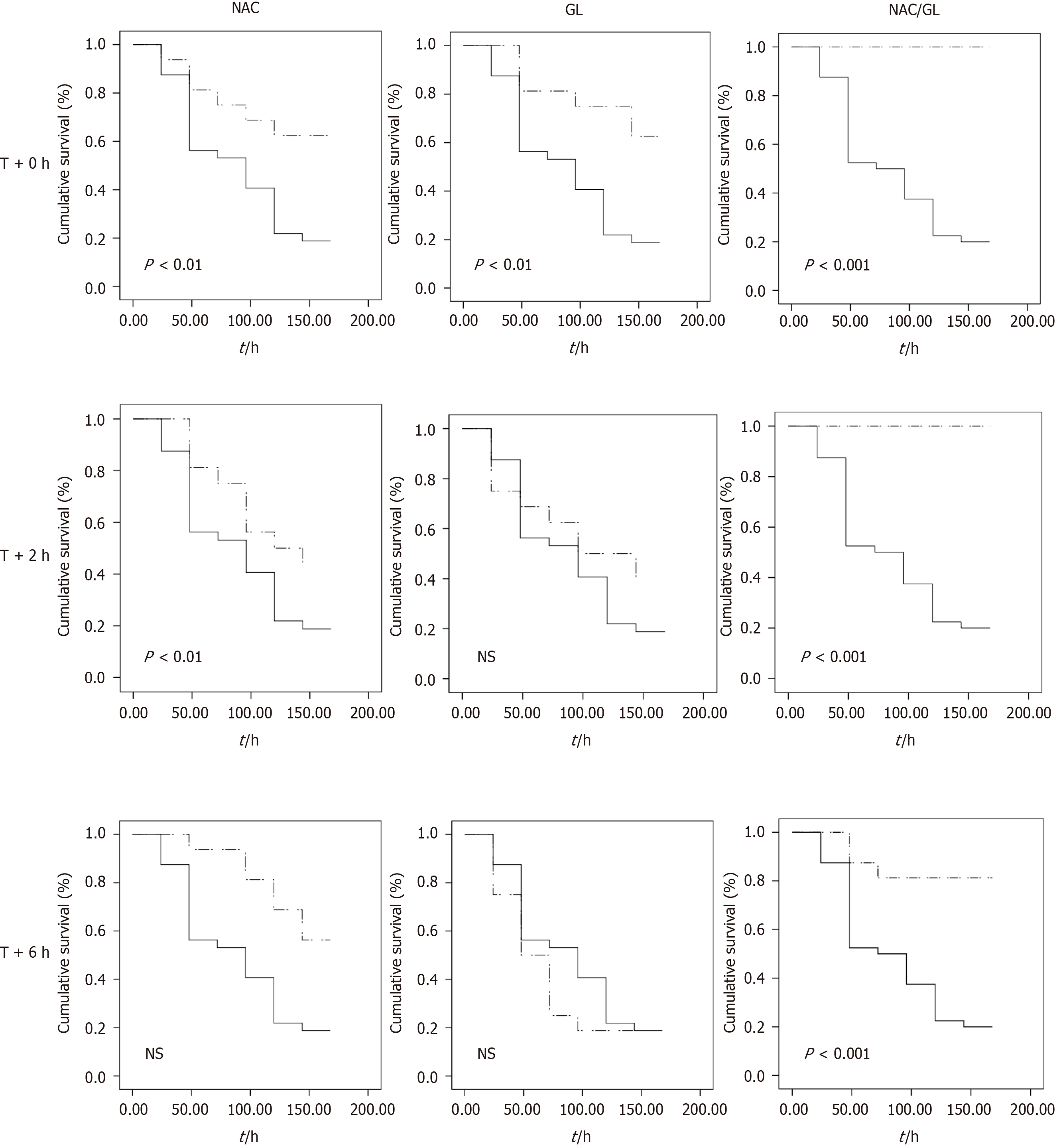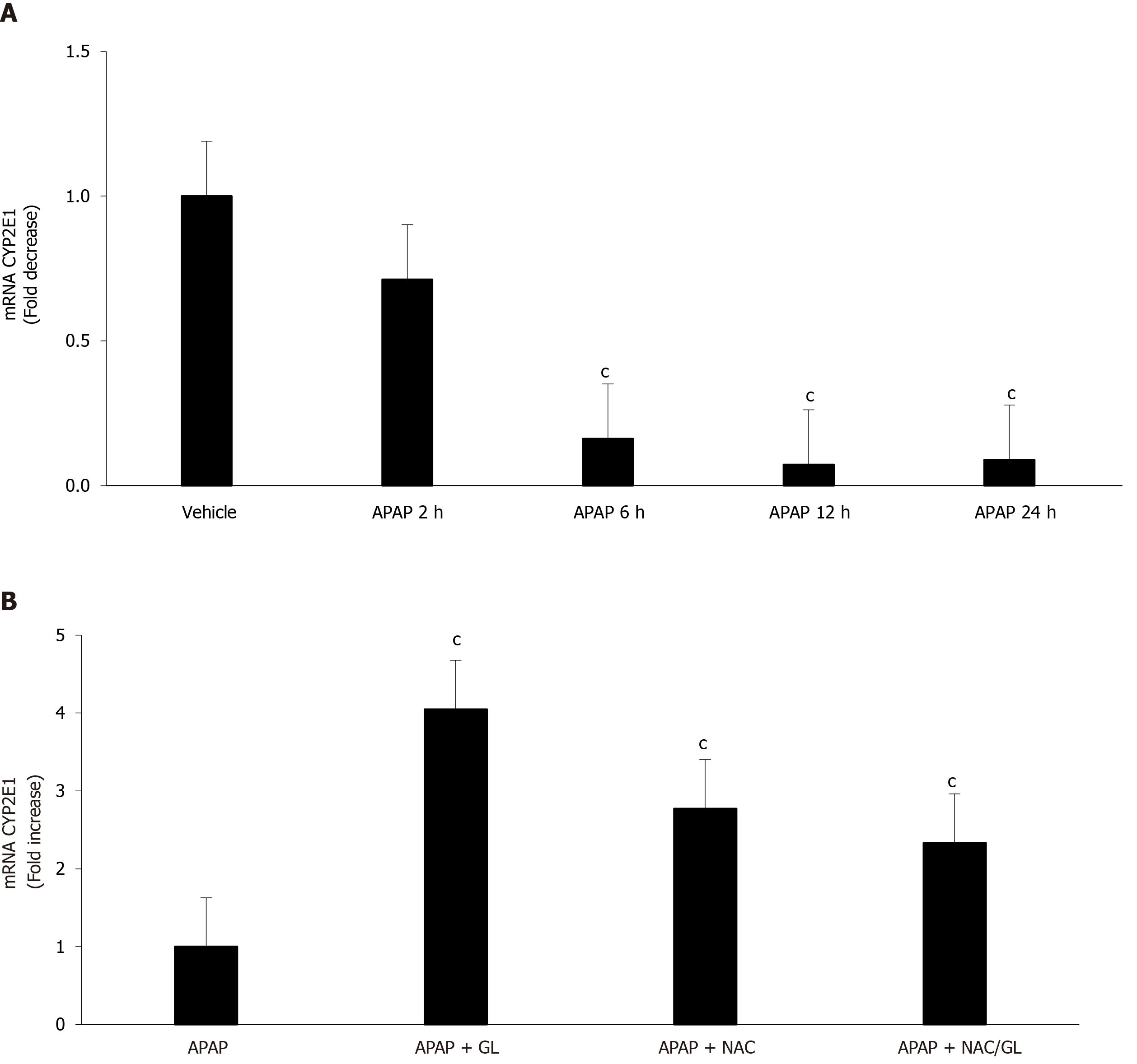Copyright
©The Author(s) 2020.
World J Hepatol. Sep 27, 2020; 12(9): 596-618
Published online Sep 27, 2020. doi: 10.4254/wjh.v12.i9.596
Published online Sep 27, 2020. doi: 10.4254/wjh.v12.i9.596
Figure 1 Murine model of acetaminophen-induced liver injury: Hepatotoxicity assessment.
A: Alanine aminotransferase (ALT) levels were measured in sera of vehicle-treated mice (0 h) and in sera of mice sacrificed 2, 6, 12 or 24 h after acetaminophen [APAP; 500 mg/kg] administration (5 mice in each group); B: Liver necrosis was scored in the same groups of mice; C: Hepatic glutathione (GSH) levels were measured at 30 min, 1 and 12 h after APAP challenge. The enzyme concentration obtained is expressed as nanomoles of enzyme per milligram of protein using bovine serum as a standard; D: High mobility group box 1 (HMGB1) levels were measured in the same groups of mice; E: Quantification of nuclear expression of HMGB1 in the same groups of mice; F: Representative hematoxylin and eosin (magnification × 200) and HMGB1-stained images (magnification × 200) of murine liver 24 h after vehicle or APAP challenge. Results are expressed as mean ± standard error. aP < 0.05, bP < 0.01 vs 0. Experiments were reproduced three times. H&E: Hematoxylin and eosin.
Figure 2 Administration of glycyrrhizin at the same time as acetaminophen, reduced the severity of liver injury.
A: Alanine aminotransferase (ALT) levels were measured after 12 h in the plasma of mice treated by vehicle or glycyrrhizin (GL) at the time of acetaminophen (APAP) injection (10 mice in each group); B: Aspartate aminotransferase (AST) levels were measured after 12 h in the plasma of mice treated by vehicle or GL at the time of APAP injection (10 mice in each group) C: Lactate dehydrogenase (LDH) levels were measured after 12 h in the plasma of mice treated by vehicle or GL at the time of APAP injection (10 mice in each group); D: Liver necrosis was scored in the same group of mice; E: Representative hematoxylin and eosin (H&E; magnification × 200) and high mobility group box 1 (HMGB1)-stained images (magnification × 400) of murine liver 12 h after APAP challenge in the same group of mice; F: HMGB1 levels were measured in the same group of mice; G: Quantification of nuclear expression of HMGB1 in the same groups of mice. Results are expressed as mean ± standard error. cP < 0.05, dP < 0.01, eP < 0.001 vs APAP. Experiments were reproduced three times.
Figure 3 Administration of N-acetylcysteine, at the same time as acetaminophen, reduced the severity of liver injury.
A: Alanine aminotransferase (ALT) levels were measured after 12 h in the plasma of mice treated by vehicle (phosphate-buffered saline; PBS) or N-acetylcysteine (NAC, 150 mg/kg) at the time of acetaminophen (APAP, 500 mg/kg) injection (n = 10); B: Aspartate aminotransferase (AST) levels were measured after 12 h in the plasma of mice treated by vehicle (PBS) or NAC (150 mg/kg) at the time of APAP (500 mg/kg) injection (n = 10); C: Lactate dehydrogenase (LDH) levels were measured after 12 h in the plasma of mice treated by vehicle (PBS) or NAC (150 mg/kg) at the time of APAP (500 mg/kg) injection (n = 10); D: Liver necrosis was scored in the same group of mice; E: Representative hematoxylin and eosin (H&E) and high mobility group box 1 (HMGB1)-stained images (magnification × 200) of murine liver 12 h after APAP challenge in the same group of mice; F: HMGB1 levels were measured in the same group of mice; G: Quantification of nuclear expression of HMGB1 in the same groups of mice; Results are expressed as mean ± standard error. cP < 0.05, dP < 0.01, eP < 0.001 vs APAP. Experiments were reproduced three times.
Figure 4 Administration of N-acetylcysteine/glycyrrhizin combination, at the same time as acetaminophen, reduced the severity of liver injury as well as glycyrrhizin or N-acetylcysteine alone.
A: Alanine aminotransferase (ALT) levels were measured in the plasma of vehicle-treated mice and mice treated with N-acetylcysteine (NAC, 150 mg/kg), glycyrrhizin (GL, 200 mg/kg) or NAC/GL, 2 h or 6 h after acetaminophen (APAP) injection (10 mice in each group); B: Aspartate aminotransferase (AST) levels were measured in the plasma of vehicle-treated mice and mice treated with NAC (150 mg/kg), GL (200 mg/kg) or NAC/GL, 2 h or 6 h after APAP injection (10 mice in each group); C: Lactate dehydrogenase (LDH) levels were measured in the plasma of vehicle-treated mice and mice treated with NAC (150 mg/kg), GL (200 mg/kg) or NAC/GL, 2 h or 6 h after APAP injection (10 mice in each group); D: Liver necrosis at 12 h after APAP challenge was scored in the same group of mice; E: Representative hematoxylin and eosin (H&E) and high mobility group box 1 (HMGB1)-stained images (magnification × 200) of murine liver 12 h after of murine liver 12 h after vehicle or APAP challenge; F: HMGB1 levels were measured in the same group of mice; G: Quantification of nuclear expression of HMGB1 in the same groups of mice. Mice were scarified 12 h after APAP administration. Results are expressed as mean ± standard error. cP < 0.05, dP < 0.01, eP < 0.001 vs APAP. Experiments were reproduced three times.
Figure 5 Acetaminophen overdose induced hepatic glutathione depletion and oxidative stress.
A: Hepatic glutathione (GSH) levels were measured in mice treated with N-acetylcysteine (NAC, 150 mg/kg), glycyrrhizin (GL, 200 mg/kg) or NAC/GL, at the same time of acetaminophen (APAP) injection (10 mice in each group). Mice were scarified 12 h after APAP administration. Assessment was performed using colorimetric assay kit. The enzyme concentration obtained is expressed as nmol of enzyme per milligram of protein using bovine serum as a standard; B: Glutathione (GSH)/the oxidized state (GSSG) ratio was evaluated in the same group of mice using fluorometric assay kit. In two separate assay reactions, GSH (reduced) was measured directly with a GSH standard and total GSH (GSH + GSSG) was measured by using a GSSG standard. Fluorescence measurement was performed at Ex/Em = 490/520 nm. Results are expressed as mean ± standard deviation. cP < 0.05, dP < 0.01, eP < 0.001 vs APAP.
Figure 6 Delayed administration of N-acetylcysteine/glycyrrhizin combination reduced acetaminophen-induced hepatocytes necrosis compare to glycyrrhizin or N-acetylcysteine alone.
A: Alanine aminotransferase (ALT) levels were measured in the plasma of vehicle-treated mice and mice treated with N-acetylcysteine (NAC, 150 mg/kg), glycyrrhizin (GL, 200 mg/kg) or NAC/GL, 2 h or 6 h after acetaminophen (APAP) injection (10 mice in each group). Mice were scarified 12 h after APAP administration; B: Aspartate aminotransferase (AST) levels were measured in the plasma of vehicle-treated mice and mice treated with NAC (150 mg/kg), GL (200 mg/kg) or NAC/GL, 2 h or 6 h after APAP injection (10 mice in each group). Mice were scarified 12 h after APAP administration; C: Lactate dehydrogenase (LDH) levels were measured in the plasma of vehicle-treated mice and mice treated with NAC (150 mg/kg), GL (200 mg/kg) or NAC/GL, 2 h or 6 h after APAP injection (10 mice in each group). Mice were scarified 12 h after APAP administration; D: Liver necrosis at 12 h after APAP challenge was scored in the same group of mice; E: Representative hematoxylin and eosin (H&E)–stained images (magnification × 200) of murine liver 12 h after vehicle or APAP challenge. Results are expressed as mean ± standard deviation. cP < 0.05, dP < 0.01, eP < 0.001 vs APAP. Experiments were reproduced three times.
Figure 7 Delayed administration of N-acetylcysteine/glycyrrhizin combination reduced high mobility group box 1 release as well as glycyrrhizin alone.
A: High mobility group box 1 (HMGB1) levels were measured in the plasma of vehicle-treated mice and mice treated with N-acetylcysteine (NAC, 150 mg/kg), glycyrrhizin (GL, 200 mg/kg) or NAC/GL, 2 h or 6 h after acetaminophen (APAP) injection (10 mice in each group). Mice were scarified 12 h after APAP administration; B: Quantification of nuclear expression of HMGB1 in the same groups of mice; C: Representative hematoxylin and eosin (H&E) and HMGB1-stained images (magnification × 200) of murine liver 12 h after APAP challenge in the same group of mice. Results are expressed as mean ± standard error. cP < 0.05, dP < 0.01, eP < 0.001 vs APAP. Experiments were reproduced three times.
Figure 8 Delayed administration of N-acetylcysteine/glycyrrhizin combination restores partially glutathione stores.
A: Hepatic glutathione (GSH) levels were measured in mice treated with N-acetylcysteine (NAC, 150 mg/kg), glycyrrhizin (GL, 200 mg/kg) or NAC/GL, 2 h or 6 h after acetaminophen (APAP) injection (10 mice in each group). Mice were scarified 12 h after APAP administration. Assessment was performed using colorimetric assay kit. The enzyme concentration obtained is expressed as nmol of enzyme per milligram of protein using bovine serum as a standard; B: Glutathione (GSH)/the oxidized state (GSSG) ratio was evaluated in the same group of mice using fluorometric assay kit. In two separate assay reactions, GSH (reduced) was measured directly with a GSH standard and total GSH (GSH + GSSG) was measured by using a GSSG standard. Fluorescence measurement was performed at Ex/Em = 490/520 nm. Results are expressed as mean ± standard error. cP < 0.05, dP < 0.01, eP < 0.001 vs APAP.
Figure 9 Delayed administration of N-acetylcysteine/glycyrrhizin combination increased mice survival following acetaminophen-induced liver injury compared to glycyrrhizin or N-acetylcysteine alone.
Comparison of cumulative probability mice survival after acetaminophen (APAP) challenge (10 mice in each group). Mice were treated with glycyrrhizin (GL, 200 mg/kg), N-acetylcysteine (NAC, 150 mg/kg) or by a NAC/GL combination. Treatment was co-administered with APAP or administered 2 h or 6 h after APAP injection. Mice were followed for 172 h. Mice were euthanized when they became moribund per the criteria of lack of response to stimuli or lack of righting reflex. Kaplan-Meier survival curves were compared using log-rank test. cP < 0.01, dP < 0.001 vs APAP. Experiments were reproduced three times.
Figure 10 Protective effects of the N-acetylcysteine/glycyrrhizin combination do not result from inhibition of hepatic expression of CYP2E1.
A: CYP2E1 mRNA expression was assessed by RT-qPCR in liver extract of vehicle-treated mice and mice sacrificed 2, 6, 12 or 24 h after acetaminophen (APAP, 500 mg/kg) injection (5 mice in each group); B: CYP2E1 mRNA expression was assessed by RT-qPCR in liver extract of mice treated with glycyrrhizin (GL, 200 mg/kg), N-acetylcysteine (NAC, 150 mg/kg), or NAC/GL, at the same time of APAP (10 mice in each group). Mice were scarified 12 h after APAP administration. The relative expression of the gene of interest was calculated using the Pfaffi method. cP < 0.05, dP < 0.01, eP < 0.001 vs APAP. Experiments were reproduced three times.
- Citation: Minsart C, Rorive S, Lemmers A, Quertinmont E, Gustot T. N-acetylcysteine and glycyrrhizin combination: Benefit outcome in a murine model of acetaminophen-induced liver failure. World J Hepatol 2020; 12(9): 596-618
- URL: https://www.wjgnet.com/1948-5182/full/v12/i9/596.htm
- DOI: https://dx.doi.org/10.4254/wjh.v12.i9.596










